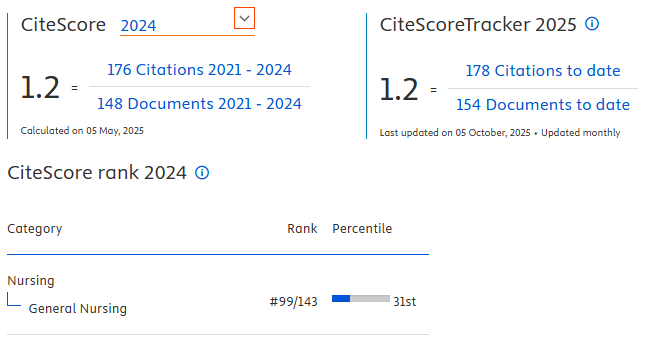Nurses’ experience of using platform for phlebitis assessment based on telemedicine consultation system: a qualitative descriptive study

Downloads
Introduction: Current methods for assessing phlebitis rely on nurses' experiences. Integrating advanced systems, such as a Clinical Decision Support System and a Telemedicine Consultation System, is essential for more comprehensive and expert-driven diagnosis and treatment recommendations. This study explored nurses' experiences using a platform for phlebitis assessment based on a telemedicine consultation system.
Methods: A qualitative study based on constructivist theory was conducted using focus group interviews with 12 registered nurses recruited from a community hospital in Thailand, between November 2022 and March 2023. The interviews were then recorded and transcribed. Data analysis followed Miles and Huberman's framework, which comprised three stages: (1) data reduction, involving the selection, organization, and coding of key data; (2) data display, structuring the data into themes to identify patterns; and (3) conclusion drawing and verification to ensure accuracy and validity through systematic comparison and cross-checking.
Results: Four themes emerged: accuracy, referring to the precision of the assessments; feasibility, which pertains to how practical the system is for daily clinical use; propriety, concerning ethical and professional considerations such as patient confidentiality and alignment with nursing practices; and utility, evaluating the overall usefulness and value of the platform in enhancing assessment efficiency.
Conclusions: The platform for phlebitis assessment based on the telemedicine consultation system can accurately evaluate and diagnose phlebitis. It is suitable for practical use in clinical settings and can improve patient care quality.
Aarts, P., et al. (2023). Validity and Reliability of Two Digital Wound Measurement Tools after Surgery in Patients with Hidradenitis Suppurativa. Dermatology, 239.1, 99-108.doi: 10.1159/000525844
Ben Abdelaziz, R., et al. (2017). Peripheral venous catheter complications in children: predisposing factors in a multicenter prospective cohort study. BMC Pediatr, 17.1, 208.doi: 10.1186/s12887-017-0965-y
Colbert, G. B., et al. (2020). Utility of telemedicine in the COVID-19 era. RCM, 21.4, 583-587.doi: 10.31083/j.rcm.2020.04.188
D'haeseleer, M., et al. (2020). Feasibility of Real Time Internet-Based Teleconsultation in Patients With Multiple Sclerosis: Interventional Pilot Study. J Med Internet Res, 22.8, e18178.doi: 10.2196/18178
Doyle, L., et al. (2020). An overview of the qualitative descriptive design within nursing research. J Res Nurs, 25.5, 443-455.doi: 10.1177/1744987119880234
Given, L. 2008. The SAGE Encyclopedia of Qualitative Research Methods.
Heng, S. Y., et al. (2023). Surgical Management of Peripheral Vein Thrombophlebitis in the Upper Extremity. J Hand Surg Glob Online, 5.1, 26-32.doi: 10.1016/j.jhsg.2022.08.010
Kaphan, K., et al. (2024). The Prevalence and Associated Factors of Peripheral Intravenous Complications in a Thai Hospital. J Infus Nurs, 47.2, 120-131.doi: 10.1097/nan.0000000000000538
Lincoln, Y. S. & Guba, E. G. 1985. Naturalistic Inquiry, Thousand Oaks, CA, Sage.
Lulie, M., et al. (2021a). Incidence of peripheral intravenous catheter phlebitis and its associated factors among patients admitted to University of Gondar hospital, Northwest Ethiopia: a prospective, observational study. Thromb J, 19.1, 48.doi: 10.1186/s12959-021-00301-x
Lulie, M., et al. (2021b). Incidence of peripheral intravenous catheter phlebitis and its associated factors among patients admitted to University of Gondar hospital, Northwest Ethiopia: a prospective, observational study. Thrombosis Journal, 19.1, 48.doi: 10.1186/s12959-021-00301-x
Lv, L. & Zhang, J. (2020). The incidence and risk of infusion phlebitis with peripheral intravenous catheters: A meta-analysis. J Vasc Access, 21.3, 342-349.doi: 10.1177/1129729819877323
Mansoor, H., et al. (2021). Utility of teleconsultation in accessing eye care in a developing country during COVID-19 pandemic. PLOS ONE, 16.1, e0245343.doi: 10.1371/journal.pone.0245343
Mihala, G., et al. (2018). Phlebitis Signs and Symptoms With Peripheral Intravenous Catheters: Incidence and Correlation Study. J Infus Nurs, 41.4, 260-263.doi: 10.1097/nan.0000000000000288
Miles, M. B. & Huberman, A. M. 1994. Qualitative data analysis: An expanded sourcebook, Newbury Park, CA, sage.
Mougiakakou, S. G., et al. (2011). A feasibility study for the provision of electronic healthcare tools and services in areas of Greece, Cyprus and Italy. BioMedical Engineering OnLine, 10.1, 49.doi: 10.1186/1475-925X-10-49
Nianios, G., et al. Accuracy assessment of a photoimaging and scanner-based wound diagnostics method. 2009 9th International Conference on Information Technology and Applications in Biomedicine, 4-7 Nov. 2009 2009. 1-4.
O'grady, N. P., et al. (2002). Guidelines for the prevention of intravascular catheter-related infections. Infect Control Hosp Epidemiol, 23.12, 759-69.doi: 10.1086/502007
Osório, N., et al. (2023). Short Peripheral Venous Catheters Contamination and the Dangers of Bloodstream Infection in Portugal: An Analytic Study. Microorganisms, 11.3, 709.doi:
Pathomjaruwat, T., et al. (2021). A Comparative Study of Accuracy and Usability between Two Extravasation Injuries Assessment Tools. Pacific Rim International Journal of Nursing Research, 25.3, 437-451.doi:
Raj, M., et al. (2022). Feasibility and Acceptability of Teleconsultation During COVID-19: A Cross-Sectional Study. Cureus, 14.10, e30937.doi: 10.7759/cureus.30937
Ray-Barruel, G., et al. (2014). Infusion phlebitis assessment measures: a systematic review. Journal of evaluation in clinical practice, 20.2, 191-202.doi:
Sandelowski, M. (2010). What's in a name? Qualitative description revisited. Res Nurs Health, 33.1, 77-84.doi: 10.1002/nur.20362
Simin, D., et al. (2019). Incidence, severity and risk factors of peripheral intravenous cannula-induced complications: An observational prospective study. Journal of Clinical Nursing, 28.9-10, 1585-1599.doi: https://doi.org/10.1111/jocn.14760
Simões, A. M. N., et al. (2022). Risk factors for peripheral intravenous catheter-related phlebitis in adult patients. Rev Esc Enferm USP, 56. e20210398.doi: 10.1590/1980-220X-REEUSP-2021-0398en
Stewart, D. W. & Shamdasani, P. M. 1990. Focus groups: theory and practice, London, Sage Publications.
Tagalakis, V., et al. (2002). The epidemiology of peripheral vein infusion thrombophlebitis: a critical review. The American Journal of Medicine, 113.2, 146-151.doi: https://doi.org/10.1016/S0002-9343(02)01163-4
Teresi, J. A., et al. (2022). Guidelines for Designing and Evaluating Feasibility Pilot Studies. Med Care, 60.1, 95-103.doi: 10.1097/mlr.0000000000001664
Thangkratok, P., et al. (2019). Determination of Infusion Phlebitis from Peripheral Intravenous Catheter from Nurse Perspective. Journal of Nursing Science Chulalongkorn University, 31.1.doi: 10.58837/CHULA.CUNS.31.1.9
Tong, A., et al. (2007). Consolidated criteria for reporting qualitative research (COREQ): a 32-item checklist for interviews and focus groups. International Journal for Quality in Health Care, 19.6, 349-357.doi: 10.1093/intqhc/mzm042
Wang, S. C., et al. (2017). Point-of-care wound visioning technology: Reproducibility and accuracy of a wound measurement app. PLoS One, 12.8, e0183139.doi: 10.1371/journal.pone.0183139
Webster, J., et al. (2008). Routine care of peripheral intravenous catheters versus clinically indicated replacement: randomised controlled trial. BMJ : British Medical Journal, 337.7662, 157-160.doi: 10.1136/bmj.a339
Wiwatkunupakarn, N., et al. (2023). The Integration of Clinical Decision Support Systems Into Telemedicine for Patients With Multimorbidity in
Primary Care Settings: Scoping Review. J Med Internet Res, 25. e45944.doi: 10.2196/45944
Wynn, M., et al. (2023). Digitizing nursing: A theoretical and holistic exploration to understand the adoption and use of digital technologies by nurses. Journal of Advanced Nursing, 79.10, 3737-3747.doi: https://doi.org/10.1111/jan.15810
Yasuda, H., et al. (2022). Risk factors for peripheral intravascular catheter-related phlebitis in critically ill patients: analysis of 3429 catheters from 23 Japanese intensive care units. Annals of Intensive Care, 12.1, 33.doi: 10.1186/s13613-022-01009-5
Copyright (c) 2025 Jurnal Ners

This work is licensed under a Creative Commons Attribution 4.0 International License.
Authors who publish with Jurnal Ners agree to the following terms:
- Authors transfer the Copyright and grant Jurnal Ners the right of first publication with the work simultaneously licensed under a Creative Commons Attribution 4.0 International License that allows others to remix, adapt and build upon the work with an acknowledgment of the work's authorship and of the initial publication in Jurnal Ners.
- Authors are permitted to copy and redistribute the journal's published version of the work (e.g., post it to an institutional repository or publish it in a book), with an acknowledgment of its initial publication in Jurnal Ners.
Jurnal Ners requires a formal written declaration and transfer of copyright from the author(s) for each article published. We, therefore, ask you to complete and return this form, retaining a copy for your own records. Your cooperation is essential and appreciated. Any delay will result in a delay in publication. The form can be downloaded HERE.
































